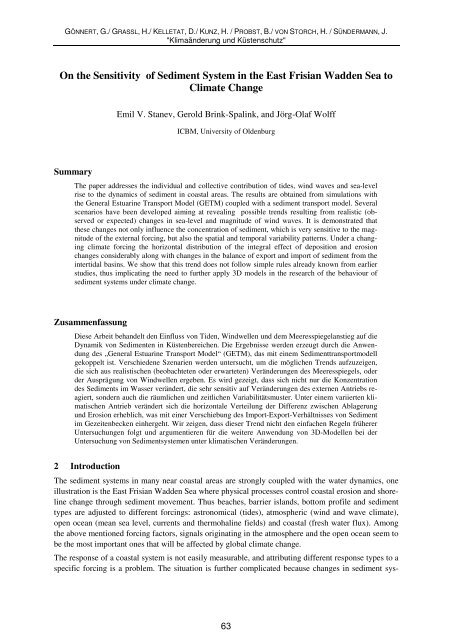Gönnert, G., Graßl, H., Kelletat, D., Kunz, H., Probst, B., von Storch, H ...
Gönnert, G., Graßl, H., Kelletat, D., Kunz, H., Probst, B., von Storch, H ...
Gönnert, G., Graßl, H., Kelletat, D., Kunz, H., Probst, B., von Storch, H ...
- TAGS
- kelletat
- kunz
- probst
- storch
- www.kuefo.de
Sie wollen auch ein ePaper? Erhöhen Sie die Reichweite Ihrer Titel.
YUMPU macht aus Druck-PDFs automatisch weboptimierte ePaper, die Google liebt.
GÖNNERT, G./ GRASSL, H./ KELLETAT, D./ KUNZ, H. / PROBST, B./ VON STORCH, H. / SÜNDERMANN, J.<br />
"Klimaänderung und Küstenschutz"<br />
On the Sensitivity of Sediment System in the East Frisian Wadden Sea to<br />
Climate Change<br />
Summary<br />
Emil V. Stanev, Gerold Brink-Spalink, and Jörg-Olaf Wolff<br />
ICBM, University of Oldenburg<br />
The paper addresses the individual and collective contribution of tides, wind waves and sea-level<br />
rise to the dynamics of sediment in coastal areas. The results are obtained from simulations with<br />
the General Estuarine Transport Model (GETM) coupled with a sediment transport model. Several<br />
scenarios have been developed aiming at revealing possible trends resulting from realistic (observed<br />
or expected) changes in sea-level and magnitude of wind waves. It is demonstrated that<br />
these changes not only influence the concentration of sediment, which is very sensitive to the magnitude<br />
of the external forcing, but also the spatial and temporal variability patterns. Under a changing<br />
climate forcing the horizontal distribution of the integral effect of deposition and erosion<br />
changes considerably along with changes in the balance of export and import of sediment from the<br />
intertidal basins. We show that this trend does not follow simple rules already known from earlier<br />
studies, thus implicating the need to further apply 3D models in the research of the behaviour of<br />
sediment systems under climate change.<br />
Zusammenfassung<br />
Diese Arbeit behandelt den Einfluss <strong>von</strong> Tiden, Windwellen und dem Meeresspiegelanstieg auf die<br />
Dynamik <strong>von</strong> Sedimenten in Küstenbereichen. Die Ergebnisse werden erzeugt durch die Anwendung<br />
des „General Estuarine Transport Model“ (GETM), das mit einem Sedimenttransportmodell<br />
gekoppelt ist. Verschiedene Szenarien werden untersucht, um die möglichen Trends aufzuzeigen,<br />
die sich aus realistischen (beobachteten oder erwarteten) Veränderungen des Meeresspiegels, oder<br />
der Ausprägung <strong>von</strong> Windwellen ergeben. Es wird gezeigt, dass sich nicht nur die Konzentration<br />
des Sediments im Wasser verändert, die sehr sensitiv auf Veränderungen des externen Antriebs reagiert,<br />
sondern auch die räumlichen und zeitlichen Variabilitätsmuster. Unter einem variierten klimatischen<br />
Antrieb verändert sich die horizontale Verteilung der Differenz zwischen Ablagerung<br />
und Erosion erheblich, was mit einer Verschiebung des Import-Export-Verhältnisses <strong>von</strong> Sediment<br />
im Gezeitenbecken einhergeht. Wir zeigen, dass dieser Trend nicht den einfachen Regeln früherer<br />
Untersuchungen folgt und argumentieren für die weitere Anwendung <strong>von</strong> 3D-Modellen bei der<br />
Untersuchung <strong>von</strong> Sedimentsystemen unter klimatischen Veränderungen.<br />
2 Introduction<br />
The sediment systems in many near coastal areas are strongly coupled with the water dynamics, one<br />
illustration is the East Frisian Wadden Sea where physical processes control coastal erosion and shoreline<br />
change through sediment movement. Thus beaches, barrier islands, bottom profile and sediment<br />
types are adjusted to different forcings: astronomical (tides), atmospheric (wind and wave climate),<br />
open ocean (mean sea level, currents and thermohaline fields) and coastal (fresh water flux). Among<br />
the above mentioned forcing factors, signals originating in the atmosphere and the open ocean seem to<br />
be the most important ones that will be affected by global climate change.<br />
The response of a coastal system is not easily measurable, and attributing different response types to a<br />
specific forcing is a problem. The situation is further complicated because changes in sediment sys-<br />
63


